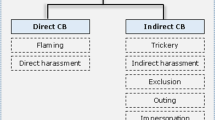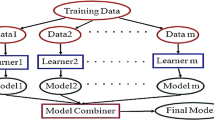Abstract
Across the globe, bullying and cyberbullying are present and have significant implications for people and communities. Over the last years, the number of research studies for cyberbullying classification in texts has grown exponentially, but most studies have been examined on English datasets. Most of the new methods in text classification are based on linguistic features of the text since the Arabic language has different rules and structures. This research intended to review articles about cyberbullying classification methods for Arabic texts and analyzed them The review includes the used methods, quality measuring performance, and details of the dataset (dialect, annotation method, source). This will guide future research by giving researchers a more consistent and compatible view on the topic. Three major databases were systematically searched for articles on related topics (Science Direct, IEEE, Google Scholar). Through a systematic study, nine research papers related to this topic are obtained. Results show that this topic’s work is still recent, and many methods have not yet been tested to figure out the best approach for classifying Arabic texts as cyberbullying. Also, the number of available datasets for cyberbullying classification in Arabic text is still limited compared to the English language. Therefore, generalizing the best method and dataset for classifying cyberbullying is so difficult. Furthermore, the majority of studies used Twitter for collecting the datasets. SVM is the most used classifier, Whereas CNN, is the most commonly used neural network for the cyberbullying classification.
Access this chapter
Tax calculation will be finalised at checkout
Purchases are for personal use only
Similar content being viewed by others
References
Patchin, J.W., Hinduja, S.: Bullies move beyond the schoolyard: a preliminary look at cyberbullying. Youth Violence Juv. Justice 4(2), 148–169 (2006)
Ivarsson, T., Broberg, A.G., Arvidsson, T., Gillberg, C.: Bullying in adolescence: psychiatric problems in victims and bullies as measured by the youth self report (YSR) and the depression self-rating scale (DSRS). Nord. J. Psychiatry 59(5), 365–373 (2005)
Agatston, P.W., Kowalski, R., Limber, S.: Students’ perspectives on cyber bullying. J. Adolesc. Heal. 41(6 SUPPL.), 59–60 (2007)
Di Capua, M., Di Nardo, E., Petrosino, A.: Unsupervised cyber bullying detection in social networks. In: Proceedings of International Conference on Pattern Recognition, pp. 432–437 (2016)
Bu, S., Cho, S.: A hybrid deep learning system of CNN and LRCN to detect cyberbullying from SNS comments. Springer (2018)
Davidson, T., Warmsley, D., Macy, M., Weber, I.: Automated hate speech detection and the problem of offensive language. In: Proceedings of 11th International Conference Web Social Media, ICWSM 2017, pp. 512–515 (2017)
Malmasi, S., Zampieri, M.: Detecting hate speech in social media. In: International Conference on Recent Advances in Natural Language Processing, RANLP, vol. 2017-Septe, pp. 467–472 (2017)
Bayari, R., Bensefia, A.: Text mining techniques for cyberbullying detection: state of the art. 6(1), 783–790 (2021)
Arwa, S., Abdallah, S.: Text mining techniques for sentiment analysis of Arabic dialects: literature review. Adv. Sci. Technol. Eng. Syst. J. 6(1), 1012–1023 (2021)
Wahdan, K.S.A., Hantoobi, S., Salloum, S.A., Shaalan, K.: A systematic review of text classification research based on deep learning models in Arabic language. Int. J. Electr. Comput. Eng 10(6), 6629–6643 (2020)
Salloum, S.A., AlHamad, A.Q., Al-Emran, M., Shaalan, K.: A survey of Arabic text mining, vol. 740 (2018)
Salloum, S.A., Al-Emran, M., Monem, A.A., Shaalan, K.: Using text mining techniques for extracting information from research articles. In: Studies in Computational Intelligence, vol. 740, Springer (2018)
Salloum, S.A., Al-Emran, M., Monem, A.A., Shaalan, K.: A survey of text mining in social media: Facebook and twitter perspectives. Adv. Sci. Technol. Eng. Syst. J 2(1), 127–133 (2017)
Salloum, S.A., Al-Emran, M., Shaalan, K.: Mining Social media text: extracting knowledge from Facebook. Int. J. Comput. Digit. Syst. 6(2), 73–81 (2017)
Salloum, S.A., Al-Emran, M., Shaalan, K.: Mining text in news channels: a case study from Facebook. Int. J. Inf. Technol. Lang. Stud. 1(1), 1–9 (2017)
Mhamdi, C., Al-Emran, M., Salloum, S.A.: Text mining and analytics: a case study from news channels posts on Facebook, vol. 740 (2018)
Al Mansoori, S., Almansoori, A., Alshamsi, M., Salloum, S.A., Shaalan, K.: Suspicious activity detection of Twitter and Facebook using sentimental analysis. 9(4), 1313–1319 (2020). https://doi.org/10.18421/TEM94-01 ISSN 2217-8309
Alshamsi, A., Bayari, R., Salloum, S.: Sentiment analysis in English texts. 5(6), 1683–1689 (2020)
Salloum, S.A., Al-Emran, M., Shaalan, K.: A survey of lexical functional grammar in the Arabic context. Int. J. Com. Net. Tech. 4(3) 141–147 (2016)
Elnagar, A., Yagi, S.M., Nassif, A.B., Shahin, I., Salloum, S.A.: Systematic literature review of dialectal Arabic: identification and detection. IEEE Access 9, 31010–31042 (2021)
Salloum, S.A.: Sentiment analysis in dialectal Arabic: a systematic review. In: Advanced Machine Learning Technologies and Applications: Proceedings AMLTA 2021, p. 407 (2021)
Khreisat, L.: A machine learning approach for Arabic text classification using N-gram frequency statistics. J. Informetr. 3(1), 72–77 (2009)
Abdeen, M.A.R., Albouq, S.: A closer look at arabic text classification. Int. J. Adv. Comput. Sci. Appl. 10(11), 677–688 (2019)
Boudad, N., Faizi, R., Thami, R.O.H., Chiheb, R.: Sentiment analysis in Arabic: a review of the literature. Ain Shams Eng. J. 9(4), 2479–2490 (2018)
Habash, N.Y.: Introduction to Arabic natural language processing. Synth. Lect. Hum. Lang. Technol. 3(1), 1–187 (2010)
Alabbas, W., Al-Khateeb, H.M., Mansour, A.: Arabic text classification methods: systematic literature review of primary studies. In: 2016 4th IEEE International Colloquium on Information Science and Technology (CiSt), pp. 361–367 (2016)
Elhassan, R., Ahmed, M.: Arabic text classification review. Int. J. Comput. Sci. Softw. Eng. 4(1), 1–5 (2015)
El Kourdi, M., Bensaid, A., Rachidi, T.: Automatic Arabic document categorization based on the Naïve Bayes algorithm, p. 51 (2004)
Dharmadhikari, S.C., Ingle, M., Kulkarni, P.: Empirical studies on machine learning based text classification algorithms. Adv. Comput. An Int. J. 2(6), 161–169 (2011)
Emmery, C., et al.: Current limitations in cyberbullying detection: on evaluation criteria, reproducibility, and data scarcity. Lang. Resour. Eval. 1–37 (2020)
Al-Shalabi, R., Evens, M.: A computational morphology system for Arabic. no. January, p. 66 (1998)
Alakrot, A., Murray, L., Nikolov, N.S.: Towards accurate detection of offensive language in online communication in Arabic. Proc. Comput. Sci. 142, 315–320 (2018)
Haidar, B., Chamoun, M., Serhrouchni, A.: Arabic cyberbullying detection: using deep learning. In: Proceedings of 2018 7th Conference on Computer and Communication Engineering ICCCE 2018, pp. 284–289 (2018)
Mubarak, H., Darwish, K., Magdy, W.: Abusive language detection on Arabic social media, pp. 52–56 (2017)
Mubarak, H., Darwish, K.: Arabic offensive language classification on Twitter. LNCS, vol. 11864. Springer (2019)
Ombui, E., Muchemi, L., Wagacha, P.: Hate speech detection in code-switched text messages. In: Proceedings of 3rd International Symposium on Multidisciplinary Studies and Innovative Technologies, ISMSIT 2019 (2019)
Haidar, B., Chamoun, M., Serhrouchni, A.: Arabic cyberbullying detection: enhancing performance by using ensemble machine learning. In: Proceedings of 2019 IEEE International Congress Cybermatics 12th IEEE International Conference on Internet Things, 15th IEEE International Conference on Green Computing and Communications 12th IEEE Cyber, Physical and Social Computing, pp. 323–327 (2019)
Rachid, B.A., Azza, H., Ben Ghezala, H.H.: Classification of cyberbullying text in Arabic. In: Proceedings of International Joint Conference on Neural Networks (2020)
Mohaouchane, H., Mourhir, A., Nikolov, N.S.: Detecting offensive language on arabic social media using deep learning. In: 2019 6th International Conference on Social Networks Analysis, Management and Security, SNAMS 2019, pp. 466–471 (2019)
Haddad, B., Orabe, Z., Al-Abood, A., Ghneim, N.: Arabic offensive language detection with attention-based deep neural networks. In: Proceedings of the 4th Workshop on Open-Source Arabic Corpora and Processing Tools, with a Shared Task on Offensive Language Detection, no. May, pp. 76–81 (2020)
Otiefy, Y., Abdelmalek, A., El Hosary, I.: WOLI at SemEval-2020 Task 12: Arabic offensive language identification on different Twitter datasets (2020)
Haidar, B., Chamoun, M., Serhrouchni, A.: A multilingual system for cyberbullying detection: Arabic content detection using machine learning. Adv. Sci. Technol. Eng. Syst. J. 2(6), 275–284 (2017)
Acknowledgment
This work is a part of a thesis submitted in fulfilment of Ph.D. in Project Management, Faculty of Engineering & Information Technology at the British University in Dubai.
Author information
Authors and Affiliations
Corresponding author
Editor information
Editors and Affiliations
Rights and permissions
Copyright information
© 2021 The Author(s), under exclusive license to Springer Nature Switzerland AG
About this paper
Cite this paper
ALBayari, R., Abdullah, S., Salloum, S.A. (2021). Cyberbullying Classification Methods for Arabic: A Systematic Review. In: Hassanien, A.E., et al. Proceedings of the International Conference on Artificial Intelligence and Computer Vision (AICV2021). AICV 2021. Advances in Intelligent Systems and Computing, vol 1377. Springer, Cham. https://doi.org/10.1007/978-3-030-76346-6_35
Download citation
DOI: https://doi.org/10.1007/978-3-030-76346-6_35
Published:
Publisher Name: Springer, Cham
Print ISBN: 978-3-030-76345-9
Online ISBN: 978-3-030-76346-6
eBook Packages: Intelligent Technologies and RoboticsIntelligent Technologies and Robotics (R0)




